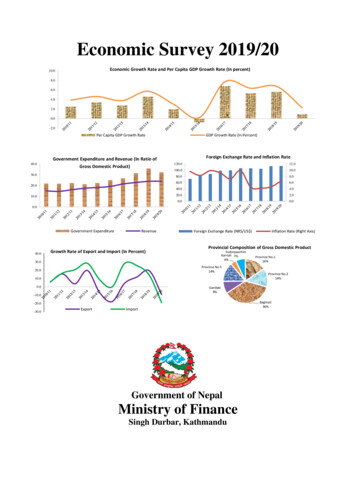
Transcription
2nd International Conference on Sustainable Development in Civil Engineering, MUET, Pakistan (December 05-07, 2019)A Stepped Wise Approach and Barriers towardsImplementation of BIM Toolkits of Infrastructure Project inPakistanFarhan Shahid 1, Zubair Ahmed 1, Tauha Hussain Ali1, Muhammad Ali Moriyani 1, Shabir Hussain Khahro21Department of Civil Engineering, Mehran-UET, JamshoroDepartment of Engineering Management, Prince Sultan University2Abstract: Building Information Modeling (BIM) has been playing a vital role in all over the world and got success inthe vertical construction field. In Pakistan, so far it has been dominant in showing stepped wise approach for itsadoption at each phase of Building projects. After its success in all aspects for vertical construction, BIM started togain the attention for many researchers about its implementation for infrastructure projects. However, literaturereview reveals that study of BIM’s implementation and its approach is still limited up to buildings only, especially inPakistan. For this purpose, a stepped wise approach towards BIM’s Implementation through collaboration of data byusing software (AUTOCAD, GIS, INFRAWORKS-360, NAVISWORKS and BIM-360 DOCS has been proposed. Asimple housing colony’s infrastructure (Roads & Drainage) is modeled to better represent the capabilities as well asbarriers of BIM in adoption for infrastructures in Pakistan. Hence, we believe that this proposed approach providesbetter way and awareness in Pakistan for acquiring BIM in Infrastructure as for buildings. In addition, thehighlighted barriers in its implementation will be helpful for the researchers to make their studies more effectiveunder this scope.Keywords: BIM Toolkits, Stepped wise approach, Barriers, Colony’s infrastructureI. INTRODUCTIONBuilding information modeling (BIM) is an intelligent 3D model-based method that gives the tools and software to theprofessionals of Architecture, structure, Engineering, and construction management at different stage of the project. BIM hasbeen successful to reduce the cost, wastages of materials, time of the project, ensures the more safety, and at the end achievingthe maximum and unbelievable efficiency of the project [1]. The Dodge data and Analytics smart market report explores the useof BIM and level of implementation in infrastructure for the four developed countries USA, UK, France and Germany. Themajority (87%) of BIM users in the study report that they are receiving positive value from their use of BIM in infrastructure [2].BIM implementation in Pakistan construction industry increased up to 9.05 % during the period 2016-2017. In 2018 only 11 %of related industry has implemented BIM and only to generate 3D models which is a very limited part of BIM. While in case ofinfrastructures, only classical software AutoCAD, and CIVIL 3D are being used for designing and 3D modeling [3].Lots of work and researches about implementation of BIM have been made. Project of buildings their architectural, structural,and MEP design, enabling the early, quick better decision taking, quantity, cost and time estimation before the commencementof projects have been proposed using BIM. So, it already has been a great significance by dealing a project through BIM.The unification and implementation of BIM in Pakistan is in flow, but the gap of the current BIM implications appears in theinfrastructure projects as it at present have been adopting for the workflow and supervision of buildings only. Despite the fact,BIM is facing several barriers in implementation within Pakistan, but this topic is under study of many researchers to meet thegaps [3]. Literature review under the area of concern has shown some benefits and the limitations of BIM in infrastructures.Where in one place the savings and value of the projects have showed to improve while on the other hand the extent to whichBIM can be applied to buildings cannot be equally applied to infrastructures projects. The adoption and use of BIM ininfrastructure projects are still slow. There was not any study and research about implementation of BIM for infrastructure inPakistan.So, a stepped wise approach is missing for the implementation of BIM in infrastructure projects in Pakistan from zero level.Therefore, to come up with a stepped wise approach, a site is selected in the boundaries of Mehran UET. Although this work islimited to a small residential colony, this approach can be taken as a benchmark for infrastructure projects in Pakistan.53
2nd International Conference on Sustainable Development in Civil Engineering, MUET, Pakistan (December 05-07, 2019)Fig. 1: Site for proposed colony (source: Google Map)II. MATERIALS & METHODSA. BIM Toolkits for Infrastructuresi GISARC-GIS played an important role in BIM. Through GIS, every site in the world could be easily digitized as it gives thegeographical information of that particular site. After the digitization of the required site, the SHP files are made with names ofrespective components involved like roads, buildings at surroundings, topography, environment conditions etc. Showing eachdetailed information of the site and its surrounding.ii AUTOCADIt was released in December 1989 as design and draft software application developed by Autodesk. It is being used in Pakistanfor buildings, roads and drainage.iii INFRAWORKS-360Infraworks-360 software supports connected BIM processes, enabling designers and civil engineers to plan and designinfrastructure projects in the context of real world [1]. It is the advanced and updated software which has real world design forroad networks for societies, highways, urban roads etc. the main advantage of using infra-works is that it designs according toreal world context, which enables the designers and site engineers to make better and fast decisions at the time of execution ofthe project.B. WHY INFRAWORKS-360?The main issue now a days with clients is that they cannot imagine what the final project will look like by just looking at the 2Ddrawings of the projects. However up-to level best, BIM has solved this problem in case of buildings by providing the 3D realtime modeling and visualization of the building projects. Which provides the 100% satisfactory and helps the clients for makingbetter decision [1]. If the level, class, scale, area and cost of the building’s projects are compared with infrastructure & colonydevelopment projects, obviously the risks, costs and scale of infrastructure projects are high. Infraworks-360 gives the ability tothe professionals of AEC industry to quickly design, collaborate and visually communicate the big picture to customers andclients and stakeholders via 3D real world modeling. Infraworks -360 fasters the team collaboration by providing thegeographically dispersed teams the ability to review designs intent and provide comment. So that one can access and viewdesign alternatives via a web browser or mobile devices in the filed helping to verify conditions.i NAVISWORKS MANAGEIt is BIM collaborated software that manage and enable the greater coordination, construction simulation, and whole-projectanalysis for integrated project review. As construction projects become increasingly complex with many moving parts, it’s moreimportant than ever to be able to simulate the flow of the project site from start to finish. The Navisworks manage enable theconstruction managers to have foresight into their projects before they even begin [1].ii BIM 360-DOCSIt is a great application that sits alongside the other apps in the BIM-360 family.it provides an online service to store and manageall project plans, models and documents [1]. It allows the publishing and viewing features from the design files and models.54
2nd International Conference on Sustainable Development in Civil Engineering, MUET, Pakistan (December 05-07, 2019)C. MethodologyData collectionfrom SiteModel ings ofSite (Unupdated)SHP Files(ARC-GIS)UpdatingLengths & InternalAnglesCoordinates2D colony Plan(AUTOCAD)INFRAWORKS-360Modeling &VisualizationSimulation(NAVISWROKSMANAGE)BIM 360-DOCSRoadsDrainageD. Stepped wise ApproachFig.2 (a): Unupdated Site (Model Builder)Fig.3(a): Road Model (INFRAWROKS-360)Fig.2 (b): Updated Site (SHP files, CAD Plan)Fig.3(b): Drainage Model (INFRAWORKS-360)55
2nd International Conference on Sustainable Development in Civil Engineering, MUET, Pakistan (December 05-07, 2019)Fig. 4:Sight Distance Analysis on Road model (INFRAWORKS-360)Fig.5 (a) Simulation of Road Model( NAVISWORKS-MANAGE)Fig.5 (b) Simulation of Drainage Model(NAVISWORKS-MANAGE)Fig.6: Adding Stakeholders & Sharing of Files (BIM 360 -DOCS)III. RESULTSThe coordinates of the site were obtained from surveying to find out the exact location of the site to extract the site contoursfrom the Model builder. The site from the Model builder was not updated so as to update the site, SHP files were used, and theCAD plan of the colony is shifted on the updated site. After updating the site, the geometric parameters of road networks in themodel like stopping sight distance , overtaking site sight distance and intersection site distances were analyzed in Infraworks.The modeling of the drainage system was done but to very limited extent . The simulation of the road and drainage network wasdone in Navisworks Manage by uploading the separated components of roads and drainage. Lastly because of the cloud-basednature of the BIM 360 DOCS, the coordination of Infraworks along with Navisworks-Manage was done to share the files withstakeholders.IV. CONCLUSIONSINFRAWORKS-360 is totally based on the preliminary design of infrastructure. It had different features for the design andanalysis of the Infrastructures. The 3D coordinates obtained from Model builder was not as accurate which restricted the56
2nd International Conference on Sustainable Development in Civil Engineering, MUET, Pakistan (December 05-07, 2019)different features of Roads design like profile-based design of road for earthwork quantities and cloud-based traffic simulationalong with the automatic drainage design, sizing the drainage network and analyzing the drainage system. The site that wasextracted From Infraworks was not updated and ARC GIS was used to do the updating. The unavailability of rainfall contentaided the barriers that impeded in the analyses of drainage network.The barriers that occurred limited this work that it could have done, had the barriers did not occur .However, this stepped wiseapproach would be helpful when any infrastructure project is done.V. RECOMMENDATIONSThe unavailability of the updated data was the main barrier that restricted the use of Infraworks . If the data was updated, thenthis could have proven to be an effective software and would have helped in different stages of infrastructure project in k products, (2019). [online] Available at: ructure Reimagined. (2019). Value of BIM in Infrastructure - Infrastructure Reimagined. [online] Available marketBhatti, I et.al, (2018). Implementation of Building Information Modeling (BIM) in Pakistan Construction Industry. vol.8, NO. 4, 2018, 3199-3202.BIM, (2019). [Online] Available at: .Liu, Y., van Nederveen, S., Wu, C. and Hertogh, M. (2018). Sustainable Infrastructure Design Framework through Integration of Rating Systems andBuilding Information Modeling. Advances in Civil Engineering, 2018, pp.1-13.Shaaban, K. and Nadeem, A. (2015). Professionals' perception towards using building information modelling (BIM) in the highway and infrastructureprojects. International Journal of Engineering Management and Economics, 5(3/4), p.273.Chong, H., Lopez, R., Wang, J., Wang, X. and Zhao, Z. (2016). Comparative Analysis on the Adoption and Use of BIM in Road InfrastructureProjects. Journal of Management in Engineering, 32(6), p.05016021.Al-Zwainy, F., Mohammed, I. and Al-Shaikhli, K. (2017). Diagnostic and Assessment Benefits and Barriers of BIM in Construction ProjectManagement. Civil Engineering Journal, 3(1), pp.63-77.57
using software (AUTOCAD, GIS, INFRAWORKS-360, NAVISWORKS and BIM-360 DOCS has been proposed. A simple housing colony's infrastructure (Roads & Drainage) is modeled to better represent the capabilities as well as barriers of BIM in adoption for infrastructures in Pakistan. Hence, we believe that this proposed approach provides









